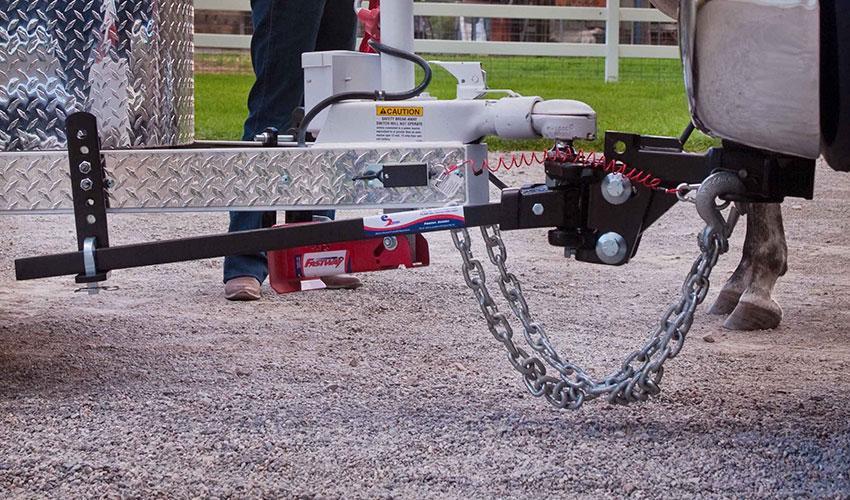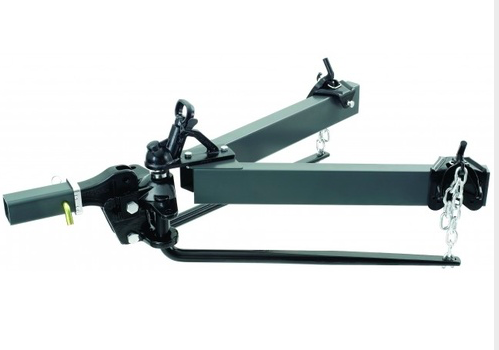Losing control of a caravan while towing is every caravan owner’s worst nightmare. A caravan weight distribution hitch is an essential towing accessory designed to evenly distribute weight across your tow vehicle and caravan, ensuring a level and stable ride.
By preventing sagging at the rear of the tow vehicle and reducing front-end lift, a weight distribution hitch Australia setup improves handling, braking performance, and overall towing comfort. Additionally, many models integrate a caravan sway control system to enhance stability and reduce the risk of swaying, especially at high speeds or in windy conditions. Failing to properly distribute your caravan’s weight can lead to severe consequences, including poor steering response, excessive tyre wear, and increased risk of accidents.
This guide will help you choose the right caravan weight distribution hitch by explaining the differences between trunnion and round bar systems. It will also compare popular options on the market, as well as step-by-step installation tips. By the end, you’ll have the knowledge to select the best hitch for safe and stable towing in Australia.
What Is a Caravan Weight Distribution Hitch?
When shopping for a caravan weight distribution hitch, you might come across terms like load leveller or equaliser. These all refer to the same essential device designed to improve towing safety and stability.
A weight distribution hitch Australia setup prevents the rear of your tow vehicle from sagging under the weight of your caravan while also stopping the front of the vehicle and the rear of the caravan from lifting. By keeping your towing combination level, it enhances handling, braking efficiency, and overall towing comfort.
.png)
Key Components of a Caravan Weight Distribution Hitch
A standard caravan weight distribution system consists of three main components:
-
Tow Ball Mount: Connects the hitch to the tow vehicle.
-
Spring Bars: Distribute weight evenly across the vehicle and caravan axles.
-
A-Frame Bracket Attachment: Secures the spring bars to the caravan’s A-frame.
Some systems use chains to provide additional tension, but all these components work together to shift weight from the rear axle of the tow vehicle to the front, ensuring balanced weight distribution.
A traditional caravan weight distribution hitch helps balance weight but does not eliminate sway. If you need additional stability, consider a dedicated caravan sway control system. Brands like Fastway E2 weight distribution hitch and Andersen No-Sway Hitches offer advanced no sway weight distribution hitch options, which we’ll explore in more detail later.
Key Towing Terminology Explained
Before diving into how weight distribution bars for caravans work, it’s essential to understand the key weight terms used in towing:
-
Tow Ball Weight (TBW): The downward force exerted by the caravan onto the tow vehicle’s hitch. This is usually 8-15% of the Aggregate Trailer Mass (ATM).
-
Aggregate Trailer Mass (ATM): The total weight of the caravan, including its payload, when fully loaded and detached from the tow vehicle.
-
Gross Trailer Mass (GTM): The caravan’s weight when fully loaded and connected to the tow vehicle. This excludes tow ball weight.
-
Gross Vehicle Mass (GVM): The maximum allowable weight of the tow vehicle, including passengers, fuel, and cargo.
-
Gross Combination Mass (GCM): The maximum weight of the tow vehicle and caravan combined, as specified by the manufacturer.
Problems Solved by Weight Distribution Hitches
Eliminating Rear Sag and Front-End Lift
A major issue when towing is the imbalance caused by excessive tow ball weight. Without a caravan weight distribution system, the rear of the tow vehicle sags, reducing traction on the front wheels. This negatively impacts steering, making it harder to control the vehicle. With a properly installed anti-sway caravan hitch, the weight is evenly distributed, keeping the front wheels firmly planted on the road and improving handling.
Improving Steering and Braking Performance
A front-end lift reduces the effectiveness of the front brakes, increasing stopping distances. By keeping the vehicle level, a no sway weight distribution hitch ensures both front and rear brakes function efficiently.
Reducing Caravan Sway
Trailer sway occurs when external forces (such as wind or passing trucks) cause the caravan to oscillate from side to side. While factors like correct loading and trunnion vs round bar weight distribution selection play a role, many modern weight distribution hitches incorporate a caravan sway control system to minimise sway.
Do You Really Need a Caravan Weight Distribution Hitch?
Not always. A caravan weight distribution hitch is primarily needed for towing long or heavy caravans. If your caravan is lightweight and well-balanced, you may not require one.
The best way to determine if you need a weight distribution hitch Australia setup is to measure the height of your tow vehicle’s front and rear wheel arches while unloaded. Then, measure the front and rear heights of your caravan when it’s level—this establishes your baseline.
After hitching up your caravan, remeasure the wheel arch heights. If there’s a drop of more than 20mm at the rear, or a noticeable lift at the front, you may need to rebalance your load. If redistributing weight doesn’t solve the issue, installing a heavy-duty weight distribution hitch can help restore stability and improve towing performance.
Types of Weight Distribution Hitches
The two most common styles of weight distribution hitches for caravans are round bar and trunnion bar designs. While both serve the same function, their structural differences impact how they fit your towing setup.
Round Bar Weight Distribution Hitch
Best for: Lower ground clearance setups
Common weight range: 135kg – 365kg (300lb – 800lb)
How it works:
-
The spring bars curve downwards before attaching to the caravan’s A-frame brackets.
-
This design allows for a more compact fit and works well for vehicles with limited clearance.
-
Typically, round bar hitches require manual sway control add-ons.
Product recommendation: Fastway E2 weight distribution hitch, which includes built-in sway control.
Trunnion Bar Weight Distribution Hitch
Best for: Higher ground clearance and heavier loads
Common weight range: 275kg – 545kg (600lb – 1200lb)
How it works:
-
The bars are straight and insert into the hitch head at a higher position.
-
This design provides more ground clearance, making it ideal for off-road towing and heavier caravans.
-
Many trunnion vs. round bar weight distribution setups already incorporate caravan sway control systems.
Product recommendation: Hayman Reese weight distribution kit, known for heavy-duty towing applications.
How To Choose The Right Caravan Tow Hitch
1. Know Your Tow Ball Weight
The first thing you need to work out is your tow ball weight. This will be 10% of your Gross Trailer Mass (GTM). You can also purchase a TowSafe Tow Ball Scale to take the guess work out and ensure you are towing you and your family safely.
Pro Tip: If your tow bar indicates a maximum tow ball weight, using the caravan tow hitch does not increase what tow ball weight you can apply.
Important: Exceeding your vehicle’s tow ball weight is illegal and dangerous. Don’t risk it!
2. Check Your Tow Ball Height
Next, look at the height of your tow ball. Many towing vehicles require a tow ball mount that can be adjusted so the tow ball can be set at higher or lower than normal. Some weight distributions hitches are bundled with a shank, which is a great solution.
3. What Size Shank Do I Require?
With the varied range of tow vehicles on the market today it will be rare to find a vehicle and a trailer that line up perfectly when towing. This is where choosing the correct size shank can make all the difference for a nice level tow.
To determine what size shank you require you, will need to have a level vehicle and trailer/caravan and get your tape measure out to do the following:
-
Hitch Height: measure from the top inside of your vehicles receiver (you will find this on your tow bar and is where the shank will connect) to the ground.
-
Coupler Height: measure from the base of your coupler (your ball mount on the caravan or trailer) to the ground.
Once you have these two measurements you will subtract your hitch height from your coupler height giving you your drop. If your trailer sits higher than your tow vehicle than you will need to subtract your coupler height from your hitch height . This will give you your rise.
.png)
Getting the correct measurement for your shank selection will ensure your caravan or trailer tows more level. Most hitches on the market offer a shank from between 3 and 6 inches which is most commonly used with tow vehicles. Some higher vehicles or ones fitted with lift kits may require a larger shank. For example:
-
When the tow vehicle is higher than the trailer - HH 14" (355mm) - CH 10" (254mm) = 4" (101mm) Drop
-
When the trailer is higher than the tow vehicle - CH 16" (406mm) - HH 13" (330mm) = 3" (76mm) Rise
Most shanks need to be compatible with your weight distribution hitch so it is not advised to mix and match your shank with your weight distribution brands.
4. Measure How Much Room You Have On The A-frame To Mount The Hitch
Most Caravans will have a jockey wheel mount welded onto the A-Frame of the caravan. It is important to check the location of this to ensure your L- bracket or clamp for spring bars will fit. Most weight distribution bars can accommodate for a varied placement of them, so be sure to check first.
Most people choose to move their jockey wheel to the centre of the A-Frame so it leaves a nice clear path for your bars to move freely.
5. How Deep Is Your A-Frame?
Traditional tow hitches were designed to suit an A-frame that is 100mm deep. However, because lots of caravan models now have A-frames made 150mm deep, it’s easier to find a caravan tow hitch with the right clearance.
6. How Is The Coupling Mounted To Your A-Frame?
The coupling is the part welded to your A-Frame that you use to connect the caravan to the tow ball on the tow vehicle. The position of this coupling can play a vital part in the type of hitch you purchase. You need to ensure your bars or chain don’t rub against your A-Frame.
These can be mounted in two positions:
-
On top of your A-Frame – a Round Bar hitch will need to be used. A trunnion can be used in some cases; you will however have to check the bars won’t hit your A-Frame.
-
Underslung coupling (your coupling is mounted inside or on the bottom of your A-Frame) - Round bar or Trunnion hitch can be used.
7. Check Your Brakes
The type of brakes on your caravan or trailer will determine your tow hitch. If you have electric brakes on your caravan, choose any of the weight distribution hitches.
Top Weight Distribution Hitch Brands in Australia
Hayman Reese
Hayman Reese is an Australian company that has been designing and manufacturing weight distribution towing systems since 1971.
These days, their popular weight distribution hitches come in a range of models: 600lb, 800lb or 1200lb (refers to the towball weight capacity).
-
600lb = 135kg – 275kg
-
800lb = 275kg – 365kg
-
1200lb = 365kg – 545kg
They are designed with either 30 or 28 inch spring bars (measured from the centre of the coupling), to suit a range of vehicles, and come in either Classic or Standard models:
-
Classic: Trunnion style bars, with integrated cams and a new lightweight, extra durable cast steel shank.
-
Standard: Round (hook) bars with integrated cams to allow for more clearance with a 6” trailer chassis.
Hayman Reese also offers a range of offset shanks to use when the lowest or highest setting on your existing shank is not low or high enough.
Fastway
This brand is renowned for its reliable and easy-to-use trailer products. The best selling Fastway hitch is the E2 model. It has everything you need for sway control and weight distribution, without the need for chains, add-on sway bars or dampening arms.
The Fastway E2 range will distribute the weight and offer sway control in an ALL-IN-ONE purchase. Giving that added safety on the road when towing. The E2 hitch comes in round-bar and Trunnion styles. The Trunnion model weighs 40-45kg, while the round bar is lighter at 37-38kg. The Trunnion hitch is best if your setup needs more ground clearance.
For both types, the GTM varies depending on the model:
-
6,000 lb (2500kg)
-
8,000 lb (3500kg)
-
10,000 lb (4500kg)
-
12,000 lb (5500kg)
These are compatible with your offroad type couplings such as the Hyland, DO35 and McHitch etc.
Andersen
Switching things up, Andersen offers chains rather than bars. These are more flexible and less noisy than bars. The WDH comes in a one size fits all and can tow up to 350kg ball weight, or 3500kg GTM. It suits a 50mm 3.5T tow ball and comes in a 4” or 8” drop/rise shank.
A standout feature of this system is its self-adjusting sway control, which operates without grease. The ball and coupler move together seamlessly to deliver exceptional anti-sway control through the “True Motion-Dampening” system. Weighing in at under 25kg, it’s significantly lighter than many other brands.
Additionally, this model can function as a standard ball mount for towing without the need for weight distribution.
Please note, this system is not compatible with off-road couplings such as the Hyland, DO35, McHitch, and similar types.
Pro Tip: The Anderson WDH is recommended for people that don’t have the strength to attach the sway bars to their mounts. These are attached with the chains and tightened with shifter or socket wrench. The still provide the same strength as the bar style hitches in terms of safety.
.png)
Accessories For Your Caravan Weight Distribution Hitch
Which accessories do you need? It depends on the tow hitch.
Depending on the height of your tow ball, you may need an off-set shank. To work out the right shank, simply measure your tow ball height. You may want to buy an adjustable shank depending on how much towing you do and whether you plan to tow different trailers with differing coupler heights.
Installation and Setup
A weight distribution hitch must be installed correctly to ensure safe and effective towing. Before you begin, these are the required tools needed for an easy installation:
-
Torque wrench
-
Socket set and spanners
-
Measuring tape
-
Tow ball grease (optional)
-
Level or spirit gauge
-
Jack and jack stands (if needed)
Step-by-Step Installation Process
1. Ensure your caravan and tow vehicle are on flat, level ground. Engage the handbrake on both to prevent movement.
2. Before hitching, take measurements of the vehicle’s wheel arches and the caravan’s front and rear heights when unhitched. These will serve as reference points to ensure the setup is correctly balanced.
3. Insert the tow ball mount into the vehicle’s hitch receiver and secure it with a locking pin. Tighten bolts to the manufacturer’s recommended torque settings.
4. Couple the caravan onto the tow ball and secure the safety chains. Ensure the jockey wheel is still in place for support before proceeding.
5: Install the Spring Bars
-
Attach the weight distribution hitch brackets to the caravan’s A-frame, ensuring they are evenly aligned.
-
Secure the spring bars into the tow ball mount, ensuring they are locked in place.
-
Hook the bars onto the brackets using the provided chains or tensioning system.
6. Raise the caravan’s front slightly using the jockey wheel to make tensioning easier. Adjust the spring bars so that the caravan and tow vehicle sit as level as possible.
7. Re-measure the wheel arch heights. If the front of the vehicle is too high or the rear too low, increase the tension. If the caravan’s nose is pointing downward, reduce the tension.
8. Double-check that all bolts, pins, and brackets are tightened to manufacturer specifications. Remove the jockey wheel and ensure the hitch is secure before driving.
Common Mistakes to Avoid & Maintenance Tips
Proper installation and regular maintenance are crucial for safe towing. Avoid these common mistakes and follow essential upkeep tips to ensure your weight distribution hitch performs reliably.
-
Incorrect Ball Weight Calculation: An overloaded tow ball can strain the hitch, affecting steering and stability. Always measure your tow ball weight accurately.
-
Improper Bracket Placement: Mount brackets at the correct distance from the coupling to prevent interference with the spring bars.
-
Uneven Tensioning: Both spring bars should have equal tension to maintain proper weight distribution and prevent swaying.
Maintenance Tips
-
Regularly check for loose bolts, worn pins, and any signs of damage.
-
Apply grease to the tow ball and pivot points to minimise wear.
-
Store the hitch in a dry place and clean it regularly to prevent corrosion and/or rust.
-
Periodically fine-tune weight distribution settings based on changing load conditions and road surfaces.
Australian Towing Regulations
Understanding and complying with Australian towing regulations ensures safety and prevents fines. Before towing, always check your state’s specific requirements and ensure your weight distribution hitch, braking system, and tow ball weight meet legal standards.
Towing Capacity Regulations
Every vehicle has a maximum towing capacity determined by the manufacturer, which includes:
-
Braked towing capacity – The maximum weight a vehicle can tow with a braked trailer.
-
Unbraked towing capacity – The limit for towing a trailer without brakes.
-
Tow Ball Mass (TBM) – The downward force exerted on the tow ball by the trailer. This should typically be 10% of the trailer’s Aggregate Trailer Mass (ATM). Exceeding these limits can void your insurance and result in fines.
Speed Limits and Following Distance Rules
-
NSW & QLD: Maximum towing speed is 100 km/h.
-
WA & NT: 110 km/h if safe to do so.
-
VIC, SA, TAS & ACT: Follow the posted speed limits.
It is also a legal requirement to maintain a safe following distance. A general rule is to allow at least 60m between your vehicle and the one ahead if towing at speeds over 60 km/h.
State-Specific Regulations
While national laws apply, each state may have additional rules:
-
Victoria & NSW: Require all trailers over 2,000 kg ATM to have breakaway braking systems that activate if the trailer detaches.
-
Queensland: Additional safety chain laws apply for heavy caravans.
-
Western Australia: Mandates specific lighting and reflectors for large trailers.
Safety Chain Requirements
All caravans and trailers in Australia must have safety chains that:
-
Comply with AS 4177.4–2004 standards.
-
Are rated for the trailer’s ATM.
-
Are crossed under the coupling to prevent the drawbar from hitting the ground if the hitch fails.
-
Use D-shackles that meet weight rating standards.
Brake Requirements Based on Trailer Weight
Australian laws specify different braking requirements depending on the trailer’s weight:
-
Under 750kg ATM: No brakes required.
-
750kg – 2,000kg ATM: Must have independent brakes (electric or override).
-
Over 2,000kg ATM: Requires breakaway brakes, which automatically activate if the trailer
Caravan WDH FAQs
What does a weight distribution hitch do?
A weight distribution hitch helps evenly distribute the weight of your caravan across all axles of your tow vehicle. This improves stability, steering, and braking while reducing sag at the rear of the tow vehicle.
Do I really need a weight distribution hitch for my caravan?
Not always. If your caravan is well-balanced and does not cause excessive sag at the rear of your vehicle, you may not need one. However, if you notice significant front-end lift or rear sag, a weight distribution hitch can help improve safety and control.
Can I use a weight distribution hitch with a DO35 off-road coupling?
Yes, but you need a special adaptor as standard weight distribution hitches are designed for ball couplings. Some off-road weight distribution systems are available to suit the DO35 coupling.
Is it legal to tow without a weight distribution hitch in Australia?
Yes, but you must stay within your vehicle’s legal towing capacity. If your tow vehicle sags excessively or is unstable, authorities may deem your setup unsafe, leading to fines or restrictions.
Final Advice
Selecting the right caravan weight distribution hitch is essential for safe and stable towing. By understanding key factors such as tow ball weight, shank size, A-frame configuration, and coupling compatibility, you can ensure a well-balanced towing setup.
When choosing a weight distribution hitch, always match it to your caravan’s weight and your tow vehicle’s specifications. Investing in a quality hitch—such as a Hayman Reese Weight Distribution Kit or a Fastway E2 No-Sway Hitch—can significantly improve towing stability.
Additionally, don’t overlook proper setup and maintenance. Regularly inspect bolts, brackets, and safety chains, and lubricate moving parts to extend the lifespan of your hitch.
Browse our selection of caravan tow hitches, or feel free to call us on 1800 787 278 or use our live chat box for expert advice or assistance.
-
DISCLAIMER* Please note, this advice is general in nature and we strongly recommend consulting the product manual and where relevant, a professional installer.








